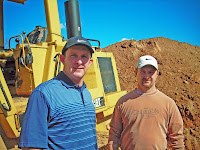From 2004 to 2008 there were tens of thousands of lots created in metro Atlanta from the development of new residential subdivisions. In 2007 the normal consumption of these lots by homebuilders was quickly halted as the early stages of the recession set in.
Gregg Goldenberg, who developed many subdivisions prior to forming Acadia Homes & Neighborhoods, utilized our company for his detention pond walls and site retaining walls. Gregg said,
“What impresses me the most about Herbert Construction is their ability to take difficult projects and make them look easy. Cobb County requirements on detention pond walls are onerous and the team at Herbert worked closely with our project engineer to ensure the walls they built were to the exacting standards that the County requires.” |
Before you knew it, there were subdivisions everywhere that were developed but vacant. Some subdivisions had a handful of homes built near the entrance, with the remaining lots unused.
These barren acres throughout metro Atlanta were nicknamed “PVC farms” for the green sewer tap pipes that stuck out of the ground on every home site. Those pipes, along with weeds and the occasional fallen, faded lot number sign replaced the activity we had been accustomed to.
If you drove all the way to the furthermost cul-de-sac in the subdivision, you’d often see a mangy couch, garbage bags of trash, or an old washing machine on its side. (For whatever reason, lazy idiots decided that discarding those items in a cul-de-sac was perfectly legal and acceptable.)
 |
Our crew sets forms for the wall of a huge detention
pond at the Great Sky subdivision in Canton. |
As builders worked their way through the Great Recession, the best of these subdivisions were methodically picked up and built out. 2011 and 2012 saw most of the subdivisions in desirable locations consumed by builders with a product that would sell.
Now, in 2013, all of the developed land in areas such as Alpharetta, Roswell and Marietta is either gone or spoken for. Home builders are scrambling to find lots in these hot-selling micro markets.
You can still find vacant developed lots in the outer areas of metro Atlanta – such as Paulding, Cherokee and Bartow Counties – but most builders don’t yet see a demand for those markets.
 |
We put the finishing touches on an outlet
control structure for a detention pond. |
This demand for developed lots in desirable locations means that developers are waking from a long hibernation to fill that need. The larger home builders are wiping the dust off their development playbooks. Residential development in Atlanta has begun again!
The development of new subdivisions brings site work for grading contractors, silt fence installers, sign makers, asphalt crews…and us.
For example, concrete retention and detention ponds are constructed to hold stormwater runoff from the streets within the subdivision, preventing the chances of flash flooding.
 |
Men from one of our footing crews tie rebar reinforcing for
the large footing of this retention pond in Woodstock. |
Our company has constructed many of these structures over the past 20 years and we’ve become specialists in this development work. We have constructed retention ponds, detention ponds, site retaining walls and subdivision entry statement foundations for many of the subdivisions you see every day on your way to work.
Some of the walls we have constructed for these structures have exceeded 24 feet in height, with footings more than 22 feet wide (almost the width of a two lane road).
The experience we’ve gained over the years allows us to suggest design tweaks and modifications that have saved our developer clients hundreds of thousands of dollars.
Our unique process for constructing the footings and walls reduces problems and speeds up the construction schedule. Our developer clients spend less time on the jobsite because they don’t have to manage our work. This allows them to focus on other tasks.
This new residential development work is a great sign for our overall housing situation here in Atlanta. It means that there is a continuing demand for new homes. It also means that home prices are rising, allowing the cost of developing raw land to be included in the price of the house. This is good for the Atlanta economy, and you – our readers of this Newsletter.












